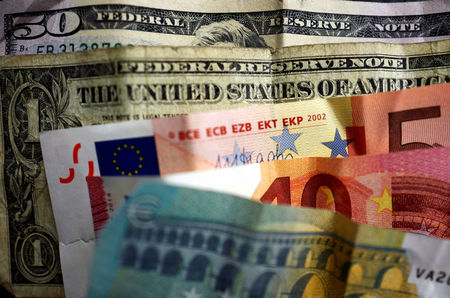
Investing.com – The U.S. dollar edged slightly lower Monday in thin holiday-affected trading, with traders awaiting key labor market data for clues of potential Federal Reserve interest rate cuts.
At 05:55 ET (09:55 GMT), the Dollar Index, which tracks the greenback against a basket of six other currencies, traded 0.1% lower to 101.577, after previously hitting 101.79, a level not seen since Aug. 20.
Activity is muted Monday given the U.S. is on holiday celebrating Labor Day.
Dollar focuses on payrolls report
The dollar rebounded last week, having sold off around 5% since the start of July, and now attention turns to the U.S. jobs report at the end of this week.
U.S. payrolls, due on Friday, will be crucial after Federal Reserve chair Jerome Powell pivoted from a battle against inflation to a readiness to protect against job losses, suggesting the likelihood of a rate cut of 25 basis points later this month.
A result in line with forecasts of a gain of 164,000 in nonfarm payrolls and a 4.2% unemployment rate would likely see the chance of a cut of 50 basis points recede completely, and it would take an extraordinarily strong report to make markets give up on 25 basis points.
Ahead of Friday’s report there are other updates on the health of the labor market, starting with Wednesday’s Jolts job openings report, which also contains data on layoffs. ADP data on private sector hiring will be released on Thursday, along with the weekly report on initial jobless claims.
Euro bounces despite weak data, political uncertainty
In Europe, EUR/USD traded 0.2% higher to 1.1067, firming after earlier hitting 1.1043, its lowest since Aug. 19.
Eurozone manufacturing activity remained in contraction territory in August, with the final eurozone manufacturing Purchasing Managers’ Index, compiled by S&P Global, coming in at 45.8 in August, firmly below the 50 mark separating growth from contraction.
The European Central Bank cut interest rates in June to try and stimulate the region’s economy, and looks likely to do so again later this month after eurozone inflation fell to 2.2% in August, a more than three-year low.
On the political front in Europe, the Alternative for Germany (AfD) became the first far-right party to win a state legislature election in Germany since World War Two with its result in Thuringia.
The German government’s faltering authority could also complicate European policy when the bloc’s other major power, France, is still struggling to form a government after snap elections in June and July.
GBP/USD gained 0.1% to 1.3138, with sterling remaining in demand, boosted by expectations that the Bank of England will keep interest rates high for longer than in the United States and the eurozone.
The BoE cut rates by 25 basis points on Aug. 1 to 5% and money markets price in a further 40 bps of cuts by year-end.
Yen, yuan slip after PMI data
In Asia, USD/JPY rose 0.4% to 146.69, with the yen retreating slightly after Japan’s factory activity contracted again in August, a private-sector survey showed earlier Monday.
The final au Jibun Bank Japan manufacturing purchasing managers’ index (PMI) rose to 49.8 in August versus 49.1 in July, and was up from 49.5 reported in the flash reading. It remained below the 50.0 threshold that separates growth from contraction for two straight months.
USD/CNY traded 0.3% higher to 7.1105, with the yuan retreating after China’s ‘official’ purchasing managers index data on Saturday gave the first insight into how the world’s second largest economy performed in August, with manufacturing activity sinking to a six-month low, contracting for a fourth straight month.
This post is originally published on INVESTING.




